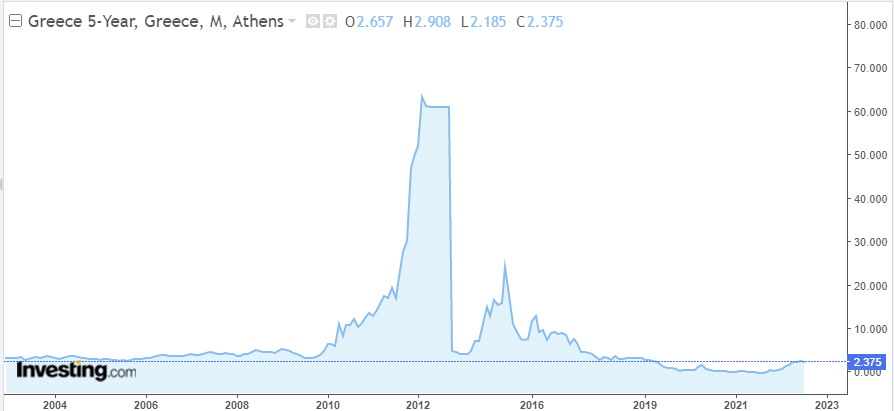What happens when a country goes bankrupt?
Sovereign defaults or country bankruptcies are a common occurrence, especially in the past decade. But this phenomenon is not entirely new. For ages, sovereign defaults or country bankruptcies have occurred and are likely to occur in the future as well.
Sovereign default news is covered in the mainstream media and many may have heard about it. The news is often sensationalized and in many cases, coverage only happens until there is a default. Following this, not much coverage takes place. This leaves many to wonder about what happens after a default.
It is not uncommon to come across such sovereign defaults, which are especially prevalent in emerging markets but can occur in any country. Some of the big-name sovereign defaults or country bankruptcies include Argentina, Russia, Iceland, and Greece to name a few.
Mostly, Latin America, countries in Africa and Asia are where most of the sovereign defaults occur. Many may just glance through the headlines, but may not really know what sovereign default is.
It is also possible that the headline itself can create panic among the defaulting sovereign's citizens. It should be noted that, unlike company bankruptcies, there are rules and regulations in place. This allows debtors to go to court for a settlement. In many cases, the court can appoint a liquidator to distribute the company’s assets.
However, given the international aspect of sovereign defaults, debtors do not have this option. Neither can debtors 'take over‘ an economy, as they may do when it comes to companies. Still, sovereign debt remains an attractive investment tool for institutional investors.
In this article, we explain what is sovereign default, why countries go bankrupt and more importantly what happens after a sovereign default. The first place, to begin with, is to understand what is sovereign debt.
What is sovereign debt?
Sovereign debt is defined as the total amount of money a country borrows. The money that is borrowed is raised via issuing bonds, also known as sovereign bonds, which are denominated in the domestic currency.
The sovereign debt can be issued at various maturities. The shortest is called Bills, which have a maturity of less than one year. Debt instruments with a maturity of up to 5 years are known as bonds or notes. And any debt instrument with a maturity longer than 5 years are known as bonds.
The bonds issued come at a face value (the principal the investor pays). In turn, the bondholder receives an interest payment. This is known as a coupon. The frequency of coupon payments can vary from quarterly to semi-annual payments to yearly.
In some cases, bonds also pay out interest only at the end of maturity. Besides these, there are other forms of bonds that a government can issue. It should be noted that the government’s Treasury department is usually responsible for issuing these bonds.
The interest payment that is made on a bond is set by market factors, accounting for economic and pollical stability, exchange rate fluctuations and so on. Besides this, there are credit rating agencies that monitor various aspects to assign a credit score.
Broadly speaking, the higher the credit score, or credit rating, the lower the interest a country has to pay. This is why countries with lower credit ratings tend to have higher interest rates or yields on the bonds they issue.
Some countries may also issue bonds denoted in foreign currency. This is done in order to shore up forex reserves and therefore indirectly helps to stabilize the foreign exchange markets.
What is a sovereign default?
A sovereign default happens when a country fails to meet its debt obligations. The debt obligations here include failing to pay the coupon on time, failing to repay the principal and so on. Even a one-day delay on coupon payments is deemed to be a default.
The most immediate consequence of a sovereign default is that the debt is wiped off. One may think of this as saying that defaulting on a debt is writing off the losses. However, this comes at a great reputational risk for the economy in question.
It has various consequences including cutting the economy from access to the international bond markets to higher costs of financing. Therefore, although as tempting as it may sound, defaulting on sovereign debt is what many countries want to avoid.
Typically, sovereign default happens due to mismanagement of funds, political corruption, financial crisis or scams and so on. Therefore, credit rating agencies look upon these factors and assign a probability of default.
Obviously, the lower the probability of a default, the more stable the economy is, and thus the borrowing costs remain low. A country’s past ability to meet its debt obligations is also taken into consideration.
Therefore, even after a country defaults, the impact of this default continues to linger.
Current world sovereign yields
What are the effects of sovereign default?
The impact of a sovereign default can have different impacts. Sometimes, the impact can be severe and in some cases, the impact can be minimal. Below are some of the most common impacts on an economy when it defaults.
Higher interest rates and yields
High-interest rates or borrowing costs are the first casualties of a sovereign default. In fact interest rates tend to rise from the moment investors get wind of a possible default. The higher borrowing costs or interest rates mean that the country has to pay more in order to borrow in the international markets.
Consequently, the country passes on these higher borrowing costs to its citizens. In the bond market terminology, the higher interest rates are referred to as yields. Typically, the yields start to rise when a country’s credit rating is lowered.
Rating agencies such as Moody’s, Standard&Poors, and Fitch monitor the global economies and assign rating statuses. An A-grade rating means that the country is stable and helps to lower borrowing costs. On the other end of the spectrum, we have junk status meaning that the economy is not creditworthy. This riskiness pushes the yields or borrowing costs for the country to skyrocket.
Exchange rate depreciation
As a consequence of a potential default, the country’s exchange rate can take a hit as well. This is a consequence of a money shortage. Central banks tend to print more money, which in turn impacts inflation.
Hyper inflation is a common consequence, as we have seen in countries like Turkey and Zimbabwe in the not-so-distant past. The exchange rate rises, making the domestic currency much weaker. The exchange rates can vary depending on how indebted a country is to the international bond markets.
The lower rates tend to make everything more expensive, from the country requiring more money to buy the same goods and services from overseas to everyday items at the store. The US dollar strength is also of importance. Many emerging market economies do not have the luxury to settle trade in their domestic currencies.
Hence, if the dollar becomes too strong, relative to a domestic currency, it can create market imbalances as well.
Forex reserves
Forex reserves are another common term one gets to hear especially during times of crisis. Forex reserves are nothing but a country’s foreign currency reserves. The forex reserves are used to settle international trade and also to hedge against exchange rate fluctuations.
Since a sovereign default will automatically increase borrowing costs, forex reserves become the next casualty on the list. As forex reserves dwindle, a country cannot afford to either maintain forex stability or settle its trade obligations.
Forex reserves are also used to pay international lenders. Consequently, this can have serious impacts.
Stock market crashes and bank runs
A consequence of all the above tends to have an impact on the country’s equity markets. A stock market crash is inevitable since inflation, exchange rate volatility and credit worthiness all play a role.
In the stock markets, there can be a mixed reaction. For example, currency devaluation, which is a consequence of an economic bankruptcy can mean different things to importers and exporters. Companies that export services and goods will see their bottom-line profits rise as the price of production falls, relative to the foreign currency payments they receive.
Meanwhile, importers will face the brunt of a weaker domestic currency since it now costs them more to import the goods and services. Currency fluctuations can also impact a company’s sales. Even big names like Apple Inc. tend to take a hit when the dollar becomes too strong or too weak.
Bank runs are also quite common. People usually tend to withdraw their deposits from the bank in an effort to convert the domestic currency into a foreign currency such as the USD. This can put undue pressure on a country’s financial system.
How does a country recover from bankruptcy?
There are many different recovery paths following a bankruptcy or a default.
First and foremost, an economic crisis tends to impact a change in governance. Therefore politics becomes the first casualty.
Typically, a government needs to seek aid from the World Bank or the IMF in order to obtain a loan.
In most cases, these loans come with conditions such as raising taxes, reducing spending, having a stable political environment and so on. Therefore, recovering from bankruptcy brings about major political and economic shifts for an economy.
The duration of the loans from such international institutions is generally cheaper, but it depends on the severity and the ability of the borrowing country to recover from the crisis. These are also known as austerity measures that were common following the 2008 global financial crisis.
In some cases, the retirement age is also increased in order to keep more citizens at work rather. Social benefits are also cut in order for the government to reduce its spending.
Greece for example managed to recover nearly 10 years after its sovereign debt crisis. The main takeaway is that after a country goes bankrupt, there is life thereafter.
The post-recovery world may seem harsh, but in many cases, it is required in order to enable the country to stand back on its feet.
What are the warning signs of sovereign default?
Although there are some standard measures to ascertain the probability of a sovereign default, there is also a bit of subjectivity involved.
Debt to GDP ratio
Debt-to-GDP ratio is the most common and standard starting point. It shows how much a country is indebted, in relation to its GDP. However, this measure alone will not give much information. For example, you can take a look at the top 10 and bottom 10 countries measured by their debt-to-GDP ratio.
You will notice that for example, Sri Lanka, the most recent country to default doesn’t rank in either percentile. At the same time, the United States is ranked number 10 as the top indebted country in the world.
Yet, the US enjoys one of the lowest borrowing rates compared to other countries.
Political stability
Political stability is another important factor that plays a role in a country’s probability of default. You can see a list of the political stability rankings here. Once again, it is interesting to note that the United States does not rank in the top 10 most politically stable countries in the world.
In fact, the US ranks at number 99. There are countries like Canada for example, which rank much higher.
Economic indicators
Economic indicators play a big role when it comes to determining credit ratings. This is because only during a healthy economy can one expect a country to meet its debt obligations. Hence, factors such as GDP growth, inflation, and unemployment rate are critical in determining a country’s economic health.
As part of this, a country’s natural resources also play a role, especially if these natural resources are used for exports of raw materials.
Credit rating agencies tend to take these factors into consideration among many more. Reviews are done periodically and the yields reflect the risk of default as a result.
In conclusion, economic bankruptcies for sovereigns is nothing new. History has shown time and again for various countries that went bankrupt but managed to recover from it. Although bankruptcy can cause pain to the average citizen in the near term, recovery from it is certainly possible.
In many cases, bankruptcy stories tend to be sensationalized and one may think that the crisis started overnight. But this is far from the truth. It takes years of political and economic mismanagement to lead a country towards defaulting on its debt obligations.






